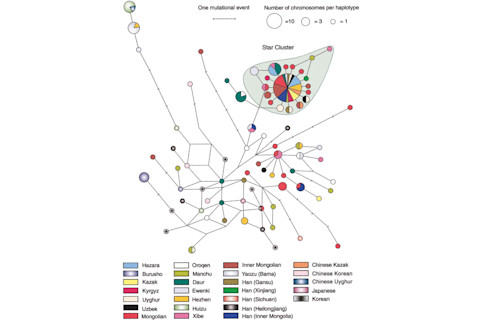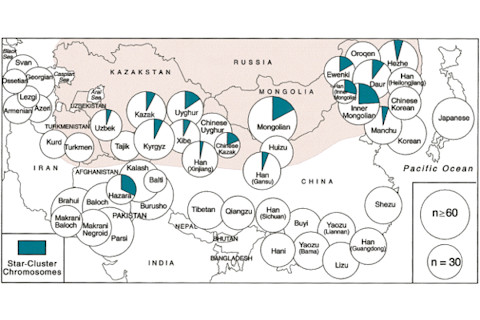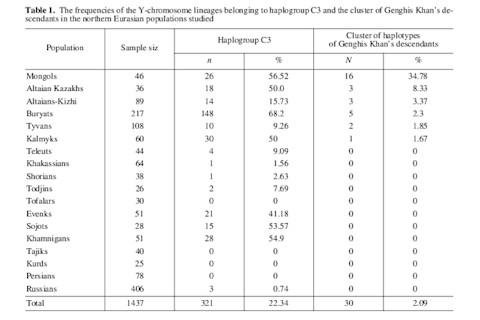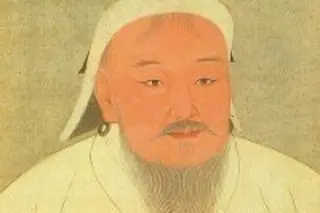This article was originally published on August 5, 2010.
In 2003, a groundbreaking historical genetics paper reported results which indicated that a substantial proportion of men in the world are direct line descendants of Genghis Khan. By direct line, I mean that they carry Y chromosomes which seem to have come down from an individual who lived approximately 1,000 years ago. As Y chromosomes are only passed from father to son, that would mean that the Y is a record of one’s patrilineage.
How Many Descendants of Genghis Khan Are There Today?
Genghis Khan died about 750 years ago, so assuming 25 years per generation, you get about 30 men between the present and that period. In more quantitative terms, about 10 percent of the men who reside within the borders of the Mongol Empire, as it was at the death of Genghis Khan, may carry his Y chromosome, and so about 0.5 percent of men in the world, about 16 million individuals alive today, do so.
Since 2003, there have been other cases of “super-Y” lineages. For example, there is the Manchu lineage and the Uí Néill lineage. The existence of these Y chromosomal lineages, which have burst upon the genetic landscape like explosive stars sweeping aside all other variation before them, indicates a periodic “winner-take-all” dynamic in human genetics more reminiscent of hyper-polygynous mammals such as elephant seals. As we do not exhibit the sexual dimorphism which is the norm in such organisms, it goes to show the plasticity of outcome due to the flexibility of human cultural forms.
More on Genghis Khan:
His empire encouraged cultural pursuits, and even provided women with a degree of power.
Genghis Khan rose to power about 800 years ago.
Jason Goldman of Thoughtful Animal reminded me of the 2003 paper, so I thought it would be useful to review it again for new readers. To understand how one Y chromosomal lineage can have such a wide distribution across such a large proportion of the human race, here is a quote attributed to Genghis Khan:
The greatest joy for a man is to defeat his enemies, to drive them before him, to take from them all they possess, to see those they love in tears, to ride their horses, and to hold their wives and daughters in his arms.
You’re probably more familiar with the paraphrase in Conan the Barbarian.
The Genetic Legacy of the Mongols: "We have identified a Y-chromosomal lineage with several unusual features. It was found in 16 populations throughout a large region of Asia, stretching from the Pacific to the Caspian Sea, and was present at high frequency: about 8 percent of the men in this region carry it, and it thus makes up about 0.5 percent of the world total. The pattern of variation within the lineage suggested that it originated in Mongolia about 1,000 years ago. Such a rapid spread cannot have occurred by chance; it must have been a result of selection. The lineage is carried by likely male-line descendants of Genghis Khan, and we therefore propose that it has spread by a novel form of social selection resulting from their behavior."
What is social selection? In this context, it’s pretty obvious. The Mongol Empire was the personal property of the “Golden Family,” the family of Genghis Khan. More precisely, this came to consist of the descendants of Genghis Khan’s four sons by his first and primary wife, Jochi, Chagatai, Ogedei and Tolui. Like the descent from the gods in the mythology of the Classical World, or the House of David in medieval Christian monarchies, a line back to Genghis Khan became a necessary precondition for fitness to be a ruler in the centuries after the rise of the Mongol Empire across much of Asia.
Who Are the Direct Descendants of Genghis Khan?
To me, the power and fury of the Mongol expansion, the awe and magnetism which Genghis Khan’s bloodline held for Asiatic societies in the wake of their world conquest, is attested to by the fact that descent from Genghis Khan became a mark of prestige even within Islamic societies.
Timur claimed a relationship to Chagatai. His descendants in India, the Timurids, retained pride in their Genghiside heritage. In Russia, among the Muslim Tatars, and in Central Asia, among the Uzbeks descent from Genghis Khan, was a major calling card for any would-be warlord.
Read more: The Life of Genghis Khan, the Ruthless Warlord Who Created the World’s Largest Empire
This is peculiar in light of the fact that Genghis Khan, and his near descendants, were non-Muslims! Not only were they non-Muslims, but the Mongol assault on West Asian Muslims societies was particularly deleterious; it is generally assumed that Iran and Mesopotamia’s relatively productive irrigation systems were wrecked during the Mongol conquests to the point where it took centuries for them to rebound to their previous levels of productivity. More symbolically, it was the Mongols who finally extinguished the Abbasid Caliphate.
In Muslim societies, pride of place is given to Sayyids, descendants of Muhammad through his grandsons Hasan and Husain. Naturally, this is often fictive, but that matters little. In fact in the Golden Horde, the northwestern region of the Mongol Empire which eventually gave rise to the Tatars who imposed the yoke on the Russians, non-Genghiside warlords produced fictive genealogies claiming descent from Muhammad as a way to negate the lineage advantage of their Genghiside rivals. But it is still shocking the hesitancy as to whether descent from Genghis Khan was more prestigious than descent from the prophet of Islam!
There was power in being direct descendants of Genghis Khan. The monopoly of the commanding heights, which his male line descendants still felt to be theirs by right of their blood, obtained at the heart of his Empire, Mongolia, downed to a very late period. The last of the great steppe polities, the Zunghar Empire, was defeated by the Manchus in part because it was led by a subset of the Oirat Mongols, a tribe whose leaders were not descended in the male line from the Golden Family, and so could not convince the Genghiside nobility of eastern Mongolia to align with them.
From the perspective of moderns, who tend to conceive of historical patterns and forces in economic, or at least ideological, terms, this fixation on blood descent seems ridiculous. I suspect that many pre-modern people, who were accustomed to small family groups and kin networks in a way we are not, would find our own surprise rather perplexing.
Descendants of Genghis Khan: The Y Chromosomal Haplotype
So what did they find in the paper? First, they discovered that there was a particular Y chromosomal haplotype, a set of unique genetic markers, which was found across much of Asia. This haplotype seems to have expanded relatively recently, as was evident from small number of mutational steps connecting all of the local variants. Figure 1 illustrates the phylogenetic network:

The shaded area represents the star-phylogeny. It’s characterized by a core haplotype, a nearby set of variants separated by one mutational step. This suggests that the genetic variant has risen rapidly in frequency before mutations had time to build up variation and generate a more complex topology. Observe the greater complexity of the network for other Y lineages.
Here is the text which explains the factors behind the rise of the Genghis Khan haplotype:
"This rise in frequency, if spread evenly over about 34 generations, would require an average increase by a factor of about 1.36 per generation and is thus comparable to the most extreme selective events observed in natural populations, such as the spread of melanic moths in 19th-century England in response to industrial pollution […] We evaluated whether it could have occurred by chance. If the population growth rate is known, it is possible to test whether the observed frequency of a lineage is consistent with its level of variation, assuming neutrality […] Using this method, we estimated the chance of finding the low degree of variation observed in the star cluster, with a current frequency of 8 percent, under neutral conditions. Even with the demographic model most likely to lead to rapid increase of the lineage, double exponential growth, the probability was <10−237; if the mutation rate were 10 times lower, the probability would still be <10−10. Thus, chance can be excluded: selection must have acted on this haplotype."
Could biological selection be responsible?
Although this possibility cannot be entirely ruled out, the small number of genes on the Y chromosome and their specialized functions provide few opportunities for selection […] It is therefore necessary to look for alternative explanations. Increased reproductive fitness, transmitted socially from generation to generation, of males carrying the same Y chromosome would lead to the increase in frequency of their Y lineage, and this effect would be enhanced by the elimination of unrelated males.
A factor of 1.36 per generation is crazy high. In theory of course drift could do this, but in theory, the molecules of gas in a room could all congeal to one corner. As noted in the text the Y chromosome is not rich in biologically useful genes. It may be that in the near future we’ll find something peculiar about the carriers of this particular haplotype, but until then, this map speaks for itself:

Mongolian Genetic Traits
The haplotype we’re focusing on clearly tracks the boundaries of the Mongol Empire as it was at the death of Genghis Khan. The main exception to this are the Hazara people of central Afghanistan, who importantly have a claim of paternal descent from Mongol soldiers who fled turmoil in Persia after the collapse of Mongol rule over that nation.
Read more: Genghis Khan Had a Soft Side
Also, the shaded areas are regions where the population density was, and is, relatively low in relation to later societies which the Mongols conquered in East and West Asia. Finally, the shaded areas were under domination of Genghiside lineages for far longer than Yuan China or the Ilkhanate of Persia. In Mongolia, northeast China, and throughout Central Asia, Genghiside lineages were paramount down to the era of the “Great Game” between Russia and the British Empire.
The 2003 paper isn’t the last word. Here’s a table from a 2007 paper that surveyed groups, which include many groups currently resident within the Russian Federation:

Of interest in this table is the relatively higher frequency among the Kazakh sample than among the Kalmyks. The Kalmyks are a people who were a fragment of the aforementioned Zunghar Empire who took refuge in the Russian Empire. They make the claim to be the only indigenous people of Europe who are Buddhists (Kalmykia is to the west of the Urals and Volga). Though more closely related to the Mongols proper than the Turkic Kazakhs in culture and genes, they do not seem to carry the lineage of Genghis Khan, as was reputedly the case in the 18th century when the Genghiside led Mongol tribes to fight them as arriviste interlopers.
In contrast, the Kazakhs have presumably mixed for centuries with the remnants of the Golden Horde. It is interesting to note that the 2007 Genghis Khan biopic Mongol had funding from the government of Kazakhstan, again attesting to the prestige that he still retains outside of Mongolia in Inner Asia.
Let’s jump back to the conclusion of the original paper:
"[…] Several scenarios, which are not mutually exclusive, could explain its rapid spread: (1) all populations carrying star-cluster chromosomes could have descended from a common ancestral population in which it was present at high frequency; (2) many or most Mongols at the time of the Mongol empire could have carried these chromosomes; (3) it could have been restricted to Genghis Khan and his close male-line relatives, and this specific lineage could have spread as a result of their activities. Explanation 1 is unlikely because these populations do not share other Y haplotypes, and explanation 2 is difficult to reconcile with the high Y-haplotype diversity of modern Mongolians […] The historically documented events accompanying the establishment of the Mongol empire would have contributed directly to the spread of this lineage by Genghis Khan and his relatives, but perhaps as important was the establishment of a long-lasting male dynasty. This scenario shows selection acting on a group of related men; group selection has been much discussed […] and is distinguished by the property that the increased fitness of the group is not reducible to the increased fitness of the individuals. It is unclear whether this is the case here. Our findings nevertheless demonstrate a novel form of selection in human populations on the basis of social prestige. A founder effect of this magnitude will have influenced allele frequencies elsewhere in the genome: mitochondrial DNA lineages will not be affected, since males do not transmit their mitochondrial DNA, but, in the simplest models, the founder male will have been the ancestor of each autosomal sequence in 4 percent of the population and X-chromosomal sequence in 2.7 percent, with implications for the medical genetics of the region [...]"
Garrett Hardin, pioneer of the “tragedy of the commons” model, also asserted that “nice guys finish last.” From what I know of the history it does not seem that Genghis Khan was any more evil or sociopathic than Julius Caesar, Charlemagne or Alexander the Great. What he had on his side was simply scale of success. So I don’t know if it truly is an example of nice guys finishing last. The biography gleaned from The Secret History of the Mongols doesn’t indicate the level of self-destructive sociopathy of Stalin or Ivan the Terrible. Rather, Genghis Khan was able to gather around himself a cadre of followers who were willing to stick with him through thick and thin.
In the life and legacy of the great Mongol warlord, I suspect we see the patterns of male domination and power projection which were the norm after the decline of hunter-gatherers, and before the rise of the mass consumer society. During this period complex civilizations built on rents extracted from subsistence agriculturalists arose. These civilizations were dominated by powerful men, who could accrue to themselves massive surpluses and translate those surpluses into reproductive advantage, which can explain how many descendants of Genghis Khan are alive today.
This pattern was not possible in the hunter-gatherer world where reproductive variance was constrained by the reality that allocation of resources was relatively equitable from person to person. But with agriculture and village society inequality shot up, and the winner-take-all dynamic came to the fore. And so the appearance on the scene genetically of super-Y lineages. Over the past 200 years, the pendulum has started to shift back, thanks to the spread of Western values and normative monogamy, which dampens the potential unequal reproductive outcomes between the rich and the poor.
Addendum: Since my surname is Khan, I should admit that I am not a direct descendant of Genghis Khan through the male line. I’m R1a1a. In South Asia “Khan” was an honorific for Muslims.
Citation: ZERJAL, T. (2003). The Genetic Legacy of the Mongols. The American Journal of Human Genetics, 72 (3), 717-721 DOI: 10.1086/367774














